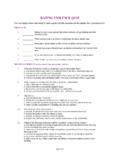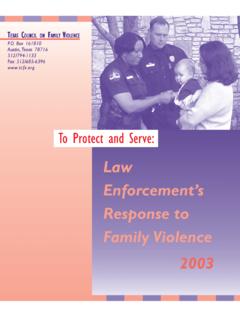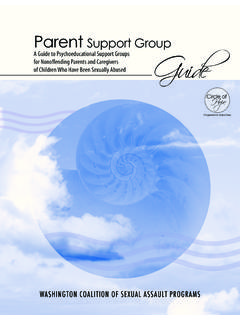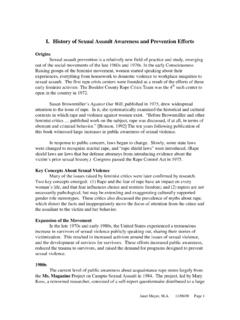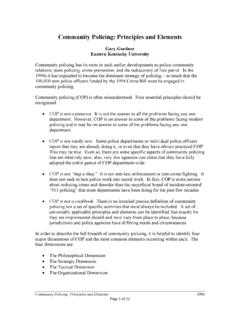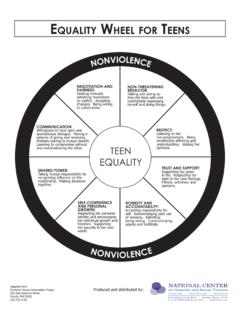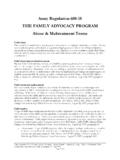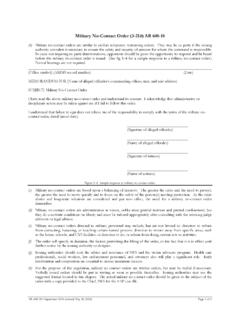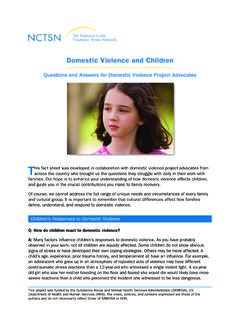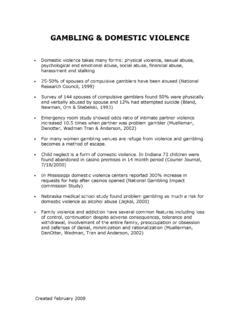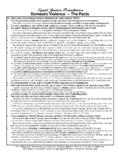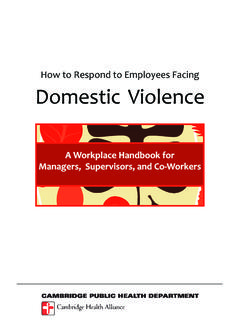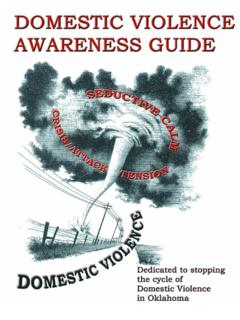Transcription of Children and Domestic Violence: Summary of State …
1 Gateways to Information: Protecting Children and Strengthening Families National Clearinghouse on Child Abuse and Neglect Information National Adoption Information Clearinghouse National Clearinghouse on Child Abuse and Neglect Information 330 C St., SW Washington, DC 20447 (800) 394-3366 or (703) 385-7565 The Clearinghouses are services of Department of Health and Human Services Administration for Children and Families Children s Bureau In recent years, increased attention has been focused on Children who may be im-pacted by violence in the home, either as direct victims or as witnesses to Domestic violence .
2 Although mandatory reporting laws have been the primary means for pro-tecting abused and neglected Children , many states now provide additional protection for Children in their Domestic violence laws. Domestic violence can be defined generally as a pattern of assaultive and/or coer-cive behaviors, including physical, sexual, and emotional abuse, as well as economic coercion, that adults use against their intimate partners to gain power and control in that relationship. 1 All jurisdictions in the United states have laws that define Domestic or family violence . In some states , Domestic violence is defined broadly with terms such as abuse, harassment, threats of harm, or intimidation.
3 In other states , the definition can include more specific behaviors such as burglary, criminal trespass, arson, sexual assault, or violation of a protective order. The persons protected by Domestic violence laws can include spouses or former spouses, persons who live or have lived together or have a dating relationship, or other family or household members. Approximately2 40 states ,3 the District of Columbia, and the Territories Guam, Northern Mariana Islands, and Puerto Rico include Children as a class of protected persons in some way within their definitions of Domestic violence .
4 Most commonly, a child who is a member of the household or a child of either adult in the relationship is protected by the law. Five states (Arizona, Hawaii, Ohio, Utah, and Vermont) include child abuse in their definition of Domestic violence . Four states (Arizona, North Caro-lina, Virginia, and Washington) specifically include grandchildren as protected per-sons, and three states (Georgia, Louisiana, and Texas) include foster Children . State Statutes Series 2004 Children and Domestic violence : Summary of State Laws Defining Domestic violence 1 Susan Schecter and Jeffrey Edleson, Effective Intervention in Domestic violence and Child Maltreatment Cases: Guidelines for Policy and Practice (Reno, NV: National Council of Juvenile and Family Court Judges, 1999), 9.
5 2 The word approximately is used to stress the fact that the states frequently amend their laws, so this information is current only through March 2004. 3 Colorado, Iowa, Kansas, Massachusetts, New Hampshire, New Jersey, Oregon, South Carolina, Wisconsin, and Wyoming do not currently include Children in their definitions of Domestic violence . Children and Domestic violence Current Through March 2004 2 This material may be freely reproduced and distributed.
6 However, when doing so, please credit the National Clearinghouse on Child Abuse and Neglect Information. A small number of states provide exceptions for certain acts in their definitions of do-mestic violence . The most common exception, in seven States4 and Guam, is for acts of self-defense. Guam also exempts defense of others, and Delaware and Louisiana exempt acts committed in defense of a child. Three states (Georgia, Illinois, and Maryland) provide an exception for reasonable acts of discipline of a child. Verbal abuse or argument is exempted by Connecticut. Research shows that even when Children are not the direct targets of violence in the home, they can be harmed by witnessing the occurrence of such The wit-nessing of Domestic violence can be auditory, visual, or inferred, including cases in which the child witnesses the aftermath of violence , such as cuts, bruises, or broken limbs.
7 Children who witness Domestic violence can suffer severe emotional and de-velopmental difficulties similar to Children who are the direct victims of The legal system is beginning to recognize the need to protect and care for these Children . Approximately 20 States7 and Puerto Rico have enacted legislation that specifically includes Children who witness Domestic violence as a class of persons in need of le-gal protection. A child is a witness to Domestic violence when an act that is defined as Domestic vio-lence is committed in the presence of or witnessed by the child. In some states , the definition goes no further than that.
8 In other states ,8 the definition is more specific, stating that witnessing by a child occurs when the offender commits the violence in the physical presence of the child or knowing that the child is present and can see or hear the act of violence . Washington uses the language within sight or sound of vic-tim s or offender s Children . Ohio law states that witnessing occurs when the domes-tic violence is committed in the vicinity of a child, meaning within 30 feet or within the same residential unit occupied by the child, regardless of whether the child is ac-tually present or can actually see the commission of the offense.
9 Minnesota includes chronic and severe use of alcohol or a controlled substance by a parent as part of the definition of exposed to Domestic violence . In many states , a conviction of Domestic violence committed in the presence of a child may result in harsher penalties. Thus, when the presence of a child during Domestic violence is considered to be aggravating circumstances, sentencing guide-lines in most states mandate that such aggravating circumstances result in a harsher criminal penalty, such as a longer jail or prison term or an increased fine. Approxi-mately eight States9 include committing an act of Domestic violence in the presence Child Witnesses to Domestic violence Legal Responses 4 Delaware, Indiana, Louisiana, Michigan, North Carolina, North Dakota, and Texas provide this exception.
10 5 For additional information about the impact of Domestic violence on Children , see the Clearinghouse publication, Children and Domestic violence : A Bulletin for Professionals, at 6 Schecter and Edelson, p. 10. 7 Alaska, Arizona, Arkansas, California, Delaware, Florida, Georgia, Hawaii, Idaho, Illinois, Indiana, Minnesota, Mississippi, Montana, North Carolina, Ohio, Oklahoma, Oregon, Utah, and Washington. 8 Alaska, Arizona, Arkansas, California, Florida, Georgia, Hawaii, Idaho, Illinois, Mississippi, Oklahoma, Oregon, and Utah. 9 Alaska, Arizona, California, Hawaii, Mississippi, Montana, Ohio, and Washington.
